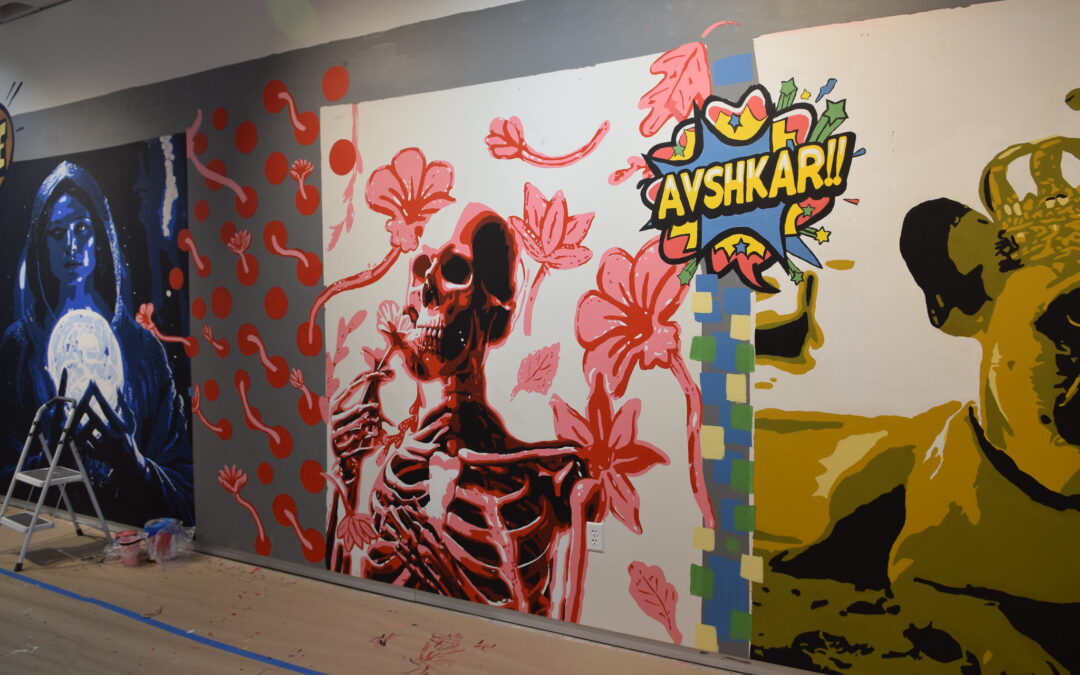By Betsy DiJulio
If you are an educator—or even if you’re not—and find yourself envious of this capstone assignment for art students at Virginia Wesleyan University (VWU), the brainchild of Professor John Rudel, you would be forgiven that deadly sin.
How he managed to roll so many goals and objectives into one assignment is a study in blue chip pedagogy. In some ways it started with a philosophical question that arose in response to the advance knowledge of MOCA Virginia’s move from the oceanfront to the VWU campus. If a sparkling new state-of-the-art museum was soon to be constructed within a stone’s throw of the Neil Britton Gallery, what should the function of the Gallery be?
Long one of the area’s small venues for big-ish names in contemporary art, that role didn’t seem to make as much sense moving forward. Rudel, who also serves as curator, decided that transitioning his 1,200 square feet of space, located in the Batten Library, into an experimental and experiential teaching lab seemed like the more appropriate function for the Gallery.
With building professional portfolios and providing students with the skills and experience necessary to earn a living front of mind for educators, Rudel crafted the Marlin Mural Fest in which the walls and other structures, like pedestals, would be covered in student conceived and painted murals over the course of the year, opening to the public in March. Throughout, not only were students’ painting skills tested and honed, but also soft skills like collaboration.
Public Art, of which murals are a lower cost and highly popular subset, is one way artists working today can earn income and a lot of it in some cases. So, students were tasked with creating and presenting design proposals to a “selection committee.” With no thematic guidelines, they were challenged to imagine with what subjects and ideas the viewing public might connect, from flower-sniffing skeletons to crown-wearing French bulldogs.
The students who submitted those proposals that were selected for inclusion became team leaders and, over the course of the project, some 75 students participated in the execution of the murals via image projection and hand-drawing and painting. Most were art students, but some were recruited roommates and other friends.
With AI a genie that is not going back in the bottle, Rudel decided to ask his students to embrace the technology as an artistic tool with the result that all but three of the murals were generated by algorithm. Once images were selected, he used Photoshop to posterize them for a consistent look and to lay a monochromatic filter over each for a color-block effect of blue, green, gold, pink, red, and violet throughout the Gallery.
One student take-away from this process is that, when collaborating, there is inevitable give and take. In this case, students had to learn to accept that some of their images might get painted out or painted over by what is, arguably, one of the most unexpected and engaging aspects of the project: what Rudel refers to as “interventions” that “stitch” the individual murals together. These are small rondels—both painted and ceramic—repetitions of small painted motifs like flowers and dots, “pop” style voice bubbles—with words intentionally misspelled as AI is wont to do—and geometric patterns interspersed between the rectangular mural panels. Each intervention overlaps what lies on either side to create a dynamic connection and flow around the gallery.
Another life lesson that students had to embrace is the concept that not all the art they produce is permanent. These murals are painted directly on the Gallery walls and will be whitewashed over in June, so be sure to see this innovative exhibition before then. While you are there, enjoy a video chronicling the process, one that is likely not to be reprised for two years. While Rudel is proud of his students and extremely pleased with the outcome, the project was such an expansive undertaking that it is likely to be a biennial rather than annual endeavor. That is, unless he has another brainstorm that supplants this one, given that he is driven to set his own bar high and ensure the students sail over it.
5817 Wesleyan Drive, VA Beach, 757.455.3200, https://www.vwu.edu/the-arts-at-virginia-wesleyan/neil-britton-gallery.php




